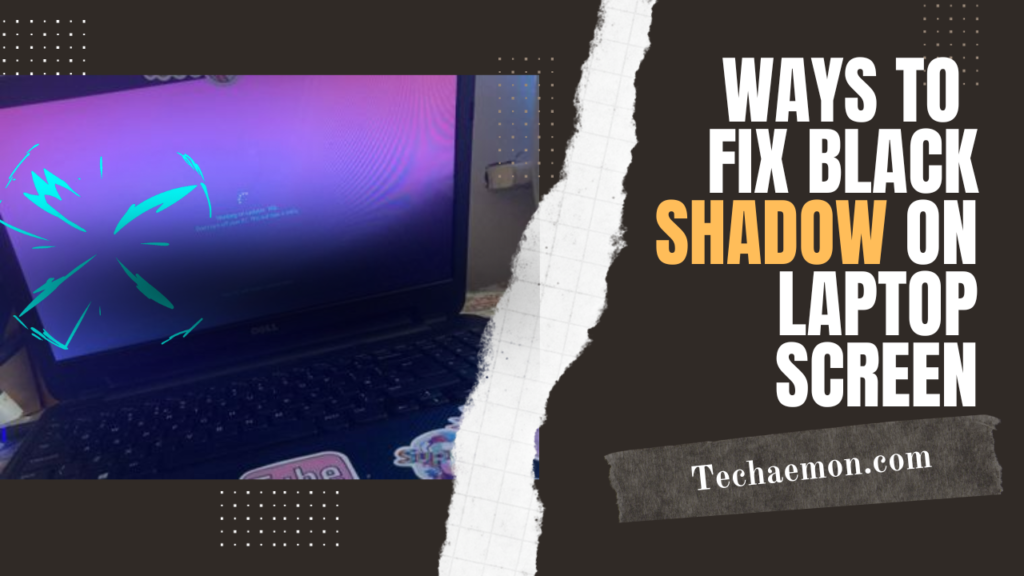When using a laptop, have you ever seen dark areas or shadows on the screen? It could be unpleasant to see shadows when working or watching films.
Many things, such as outdated graphics card drivers, dirt or smudges on the screen, improper screen settings, and hardware problems, can cause shadows on a laptop screen.
Increasing the brightness of your screen or cleaning your monitor can easily remove shadows; however, more significant issues might call for expert repair services.
If you notice shadows on your laptop’s screen, you need to figure out what’s causing it and look for the best solutions.
Removing shadows from displays will improve your viewing experience.
Contents
What Does a Laptop Screen’s Black Shadow Mean?
A dark or unusually dim area on a laptop screen that arises from underlying problems with the display is called a black shadow.
Screen flaws, graphics issues, software bugs, or outside influences usually cause black shadows on laptop screens.
Causes of the Black Shadow on Your Laptop’s Screen
Before moving on to solutions, understanding the reasons behind the black shadows or spots on your laptop screen is essential.
Graphics Card Issue
A malfunctioning graphics card usually causes the appearance of a black shadow on your laptop screen.
On laptop screens, anomalies such as occasional graphical glitches, incorrectly colored pixels, or screen flickering are frequently represented by a black shadow.
Your laptop’s graphic card may be broken if you’ve experienced these hiccups.
Shadow Monitor
A shadow monitor is a monitor your computer system has identified but is not physically present.
Black shadows, lines, or faded, fuzzy images may occasionally appear on your laptop’s screen when your computer system mistakenly detects a nonexistent monitor.
Light Leakage
A prevalent issue with the LCD panels found in most laptops is light leakage.
Also known as backlight bleeding, this is typically the result of thinner display panels and higher pixel densities.
Flexing thin display panels increases the possibility of uneven pressure on the backlighting system
and varying brightness levels around the screen’s edges or corners, giving the impression that the laptop screen has a black shadow.
Ways to Remove the Black Shadow From a Laptop Screen
Let’s look at some tried-and-true solutions for black shadows on laptop screens, so don’t worry if they bother you.
Fix the Dead Pixel
There’s no assurance that a dead pixel will come back to life.
It’s possible that you mistook a stuck pixel for a dead one, so it’s worth trying to fix it.
There is no software to assist you if dead pixels are caused by a hardware issue, which is their most common cause.
Replacing the entire screen is the only way to address a dead pixel.
Fix a Stuck Pixel
If you’ve found a stuck pixel, fixing it might be relatively easy. Restarting your laptop is all that is required.
Usually, doing this is sufficient to reset the pixel and restore functionality.
Installing one of the many tools made to unstick a pixel is an additional option.
Replace Laptop Screen
If you’ve tried all the other solutions listed above and your laptop screen still displays black spots, there’s a chance that a hardware issue and screen damage have been responsible.
Replacing your laptop screen might be your only remaining option in such circumstances.
It is crucial to keep in mind that replacing a laptop screen is a difficult process that requires specialized knowledge.
Therefore, you should get it fixed by a professional repair service or through the manufacturer’s service center for laptops.
Cleaning
Cleaning is the most obvious solution if accumulated dirt and debris are the cause of the dark, shadowy areas on your laptop’s screen.
Yet, when cleaning delicate laptop screens, you must exercise caution and thoroughness. If you don’t, you might end up causing even greater harm.
Before starting any cleaning, make sure your laptop is turned off.
Only a soft, lint-free cloth, such as a microfiber cloth, can be used to clean the screen of your laptop.
You can be certain that the display is free of scratches by taking this action after cleaning it.
Use a display-specific cleaning solution or moisten the fabric with clean water.
Seek Professional Help
If you are unable to solve the issue on your own, it may be better to seek professional assistance.
If it’s still under warranty, your laptop can be fixed for free.
Even though the laptop’s warranty has expired, it is still recommended to get in touch with the manufacturer’s customer support team for assistance.
Conclusion
Consider these solutions if your laptop screen has a dark shadow: Updating graphics drivers is the first step in ensuring compatibility.
Next, look for loose or damaged screen cables. Third, adjust display settings like contrast and brightness.
Lastly, run a malware scan to rule out software issues. If the problem persists, a hardware malfunction may necessitate professional assistance.
In summary, troubleshooting procedures involve checking connections, updating drivers, changing settings, and resolving software-related issues before seeking professional assistance for potential hardware issues.
FAQ’s
Q1. What causes the shadow on my laptop’s screen?
Damage to the screen or misaligned internal components could be the source of a vertical shadow or line.
The cable that connects the laptop’s screen to the motherboard could break or come loose over time.
Q2. Is it possible to fix black spots on a laptop screen?
Determining the underlying cause of black spots on a laptop screen is the first step toward finding a solution.
Dead pixels cannot be fixed, but stuck pixels can be freed with software tools and dirt and debris removed.
On the other hand, pressure and water damage, including burn-in, may require expert repair and screen replacement.
Q3. Can a broken laptop screen be fixed?
A broken laptop screen can be fixed without the LCD panel needing to be replaced.
Changing out damaged parts, such as the glass cover or backlight, can frequently fix screen issues.
The specific options for repairing the laptop will depend on the extent of the damage as well as its make and model.
Q4. How can an internally cracked laptop screen be fixed?
Take it to a professional to assess the damage and find out if there is an internal crack that can be fixed for the screen.
In certain situations, it might be necessary to alter the screen. It is essential to have the laptop inspected by a professional to ensure both its functionality and safety.
Q5. Is it worthwhile to repair laptop screens?
It does not make sense to overspend on repairs.
If you find that your computer contains important files or applications that would be difficult to transfer and configure on a new laptop, it might be worth it.
More often than not, other components of the laptop are impacted when a laptop screen breaks.



Pingback: How to Fix a Broken Laptop Hinge | Best Fixes in 2024
Pingback: Best Ways to Fix Black Horizontal Lines on Laptop Screen 2024